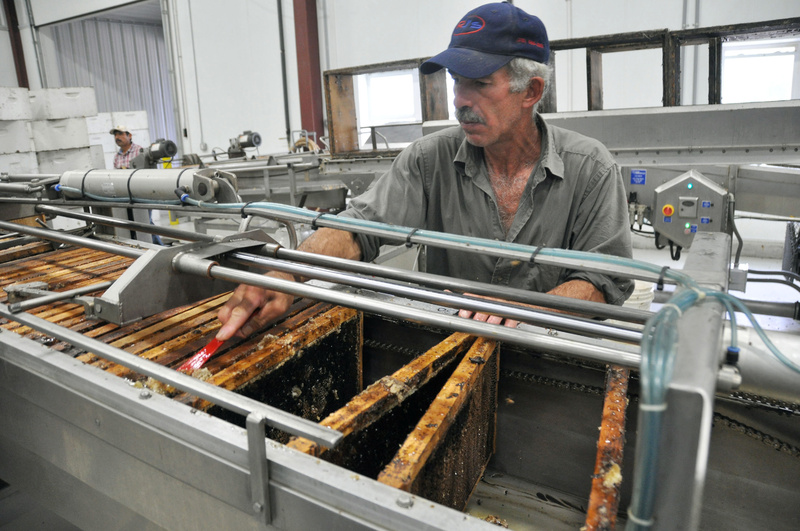BRUCE, S.D. — South Dakota honey producer Richard Adee pulls a rectangular beehive frame from an extracting machine and points to a bell curve-shaped pattern of honey and wax.
In a good year, the frame would be full.
Adee Honey Farms in Bruce will extract and ship about 5 million pounds of honey this year, off from what Adee considers a good year of about 8 million pounds.
“We’re on the tail end of the summer and it’s definitely going to be a short crop,” he said this week.
Adee is not alone. A month-long stretch of cooler summer temperatures in the Dakotas has honey producers anticipating a drop in the states’ honey crops as extracting gets under way.
North Dakota and South Dakota are the nation’s top two honey producing states, with North Dakota churning out 34 million pounds in 2012 and South Dakota producing 17 million pounds.
The U.S. Department of Agriculture won’t release its 2013 production numbers until the spring, and there’s no telling how much a short crop could affect prices at the supermarket.
Bob Reiners, South Dakota’s state apiarist, said he has taken calls from nervous producers who say they have bills to pay but not much honey in the brood boxes. The culprit appears to be mid- to late-summer temperatures that have too frequently been below normal, he said.
“It seems to be the bulk of the honey thus far was made real early,” Reiners said.
It has been a tale of two seasons in North Dakota.
Producers have been enjoying great conditions in the western and northern parts of the state, but eastern North Dakota has been suffering from a lack of warmth and a continuing drop in the number of nectar producing plants, said Bonnie Woodworth, director at large of the North Dakota Beekeepers Association.
“Eastern North Dakota, they’re just really lacking on forage,” Woodworth said. “There’s just so much corn and soybeans. Soybeans will produce, but it needs to be warm nights and hot days and they just haven’t had that.”
The Dakotas honey slowdown comes on the heels of continuing bee losses from colony collapse disorder, a mysterious phenomenon that has caused as much as one-third of the nation’s bees to just disappear each winter since 2006. A federal report blames a combination of intertwined factors that include a parasitic mite, multiple viruses, bacteria, poor nutrition, genetics, habitat loss and pesticides.
“Boy, it really hit hard this last winter,” Adee said. “We lost 42 percent of the bees we ship to California, and that’s about the national average. We can’t sustain those losses.”
During a typical summer, bees will continue to carry pollen back to their hives until the early part of September, and producers will extract honey from frames through October.
Adee said warmer temperatures this week could help the bees still in the fields pick up the pace, but beekeepers prefer temperatures in the 80s rather than the 90s or 70s.
“We’re all hoping for a good two weeks left of the summer to kind of bring things up a little a bit, and it could make a little difference,” he said. “But it’s getting late. The flowers are just about gone.”
As big as Adee’s honey operation is, it’s secondary to his pollination business.
At summer’s end, the colonies will be shipped to California to pollinate almond crops and then head north to Washington to pollinate apples. They’ll then head down south for bee-breeding operations in Mississippi and Texas.
“Those bees are little tourists, and they don’t even get frequent flyer miles,” Adee said.
Send questions/comments to the editors.



Comments are no longer available on this story